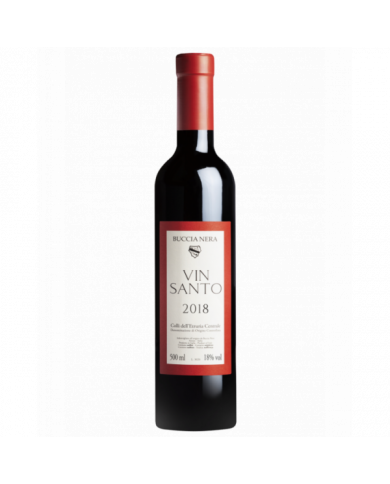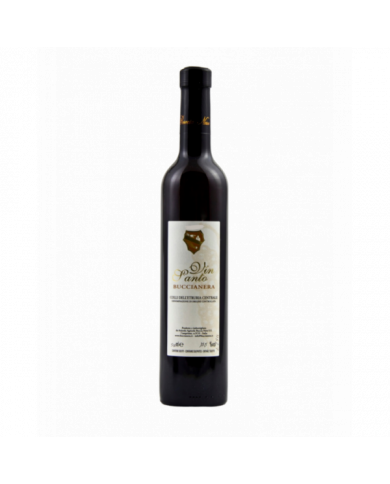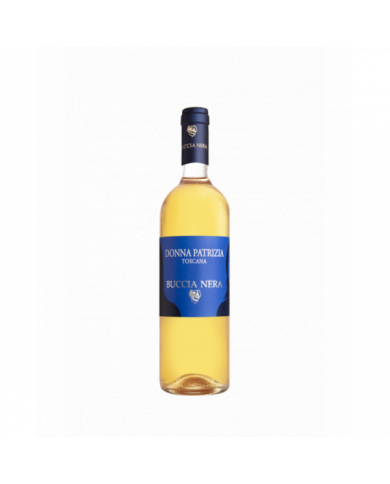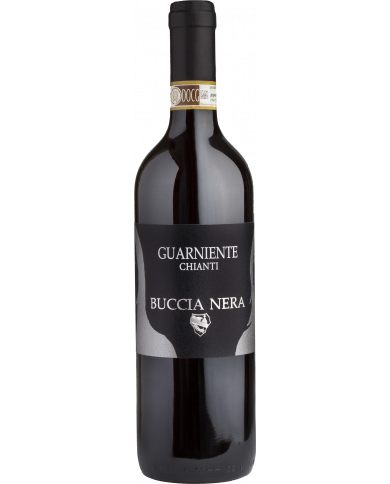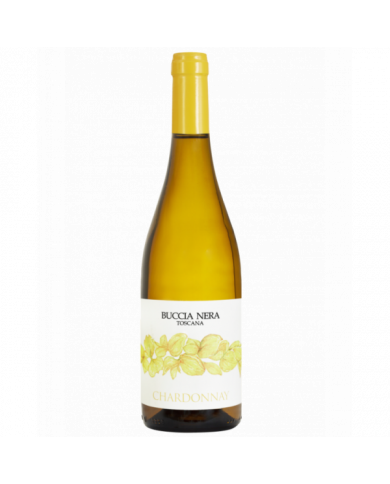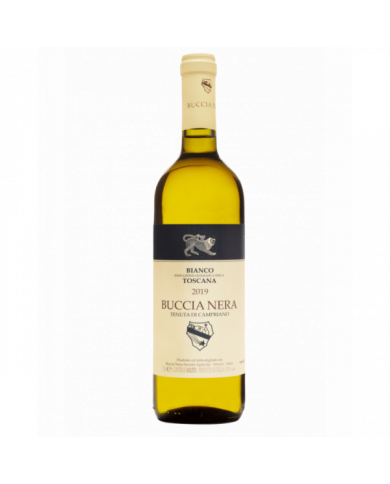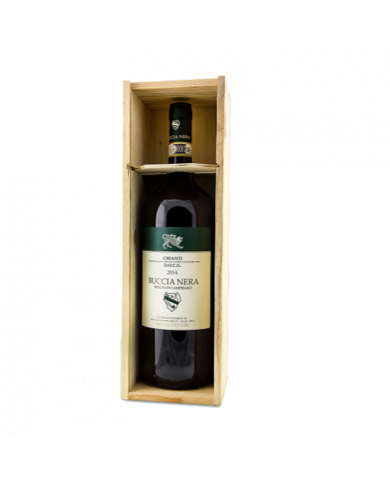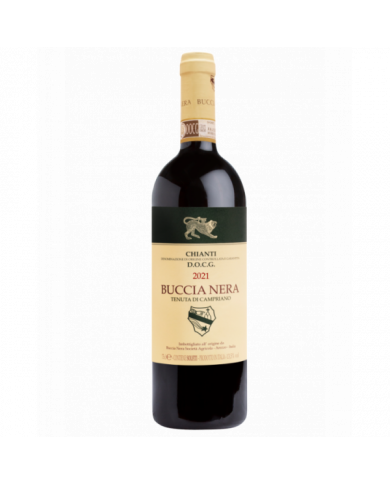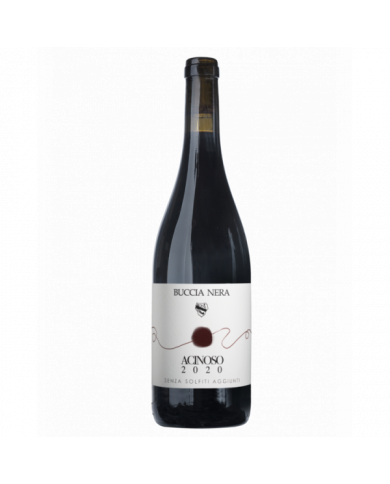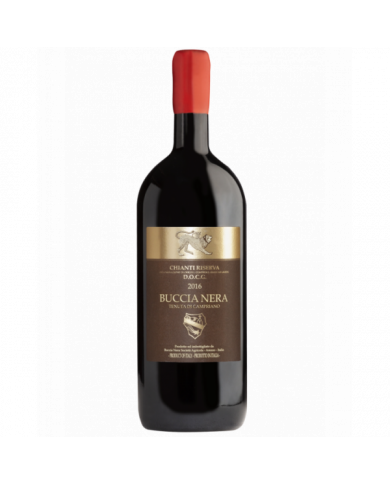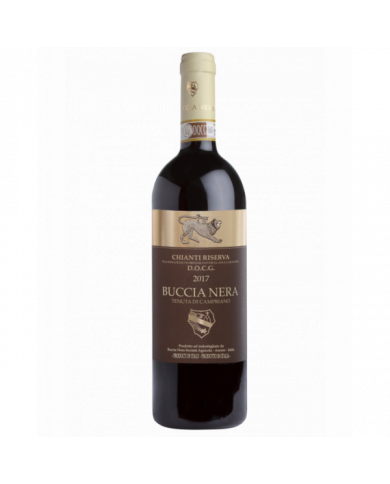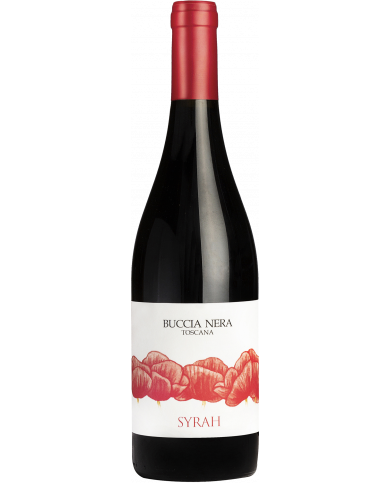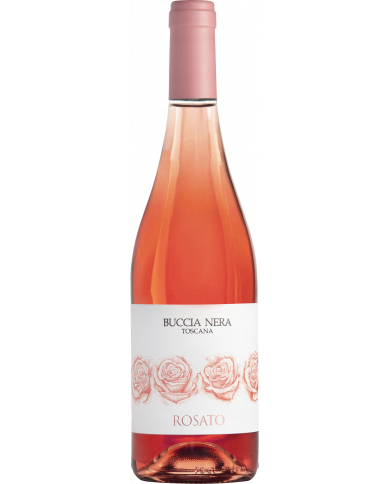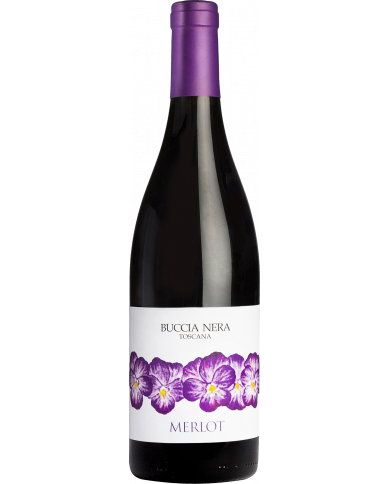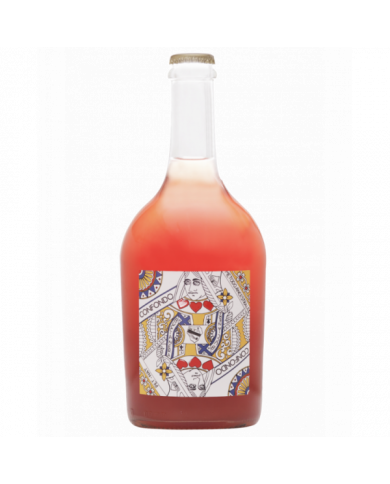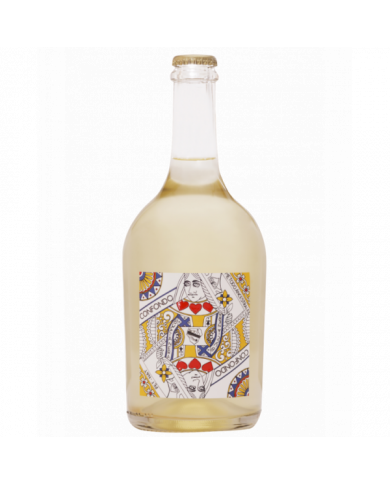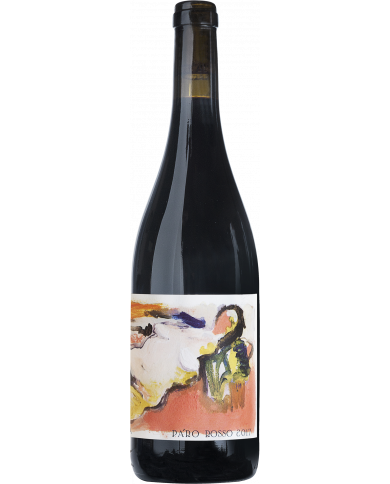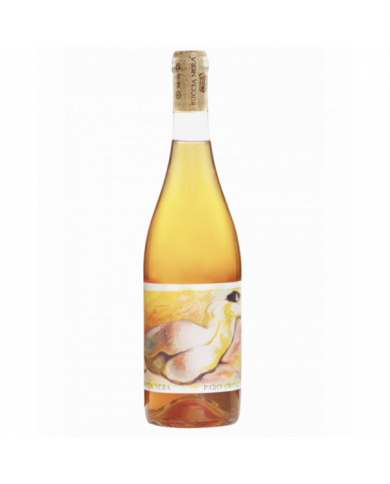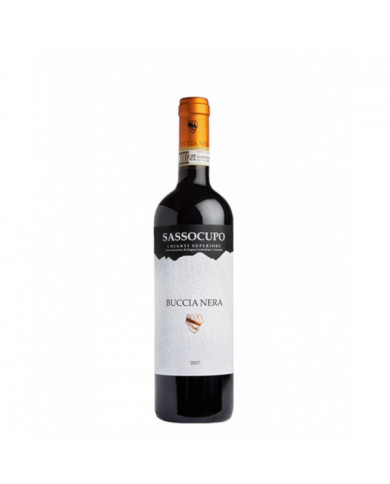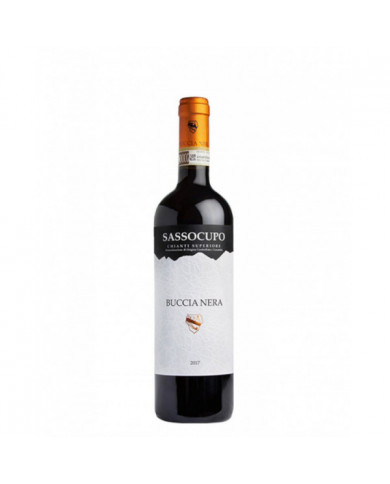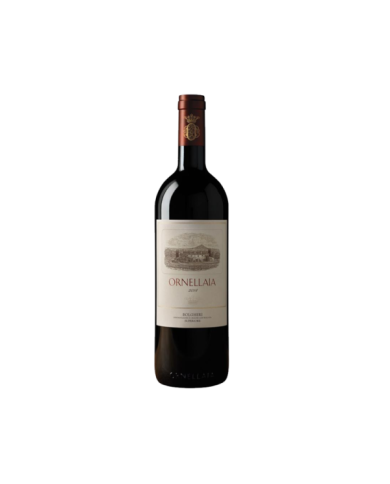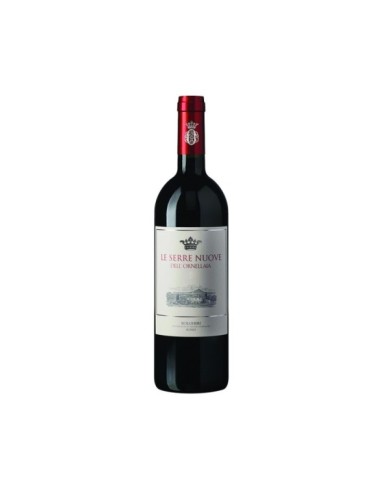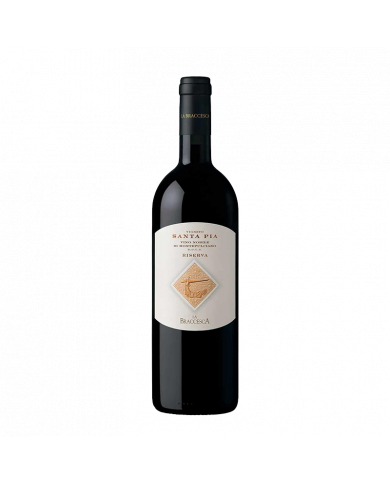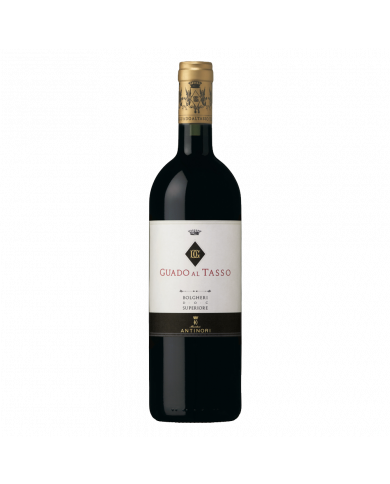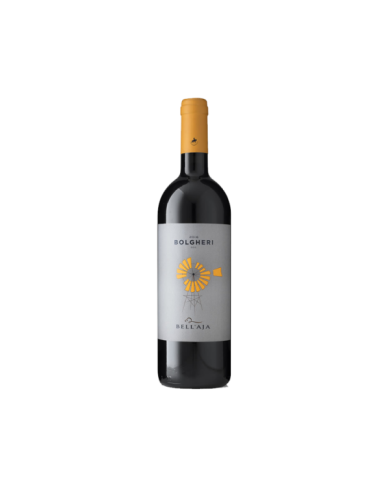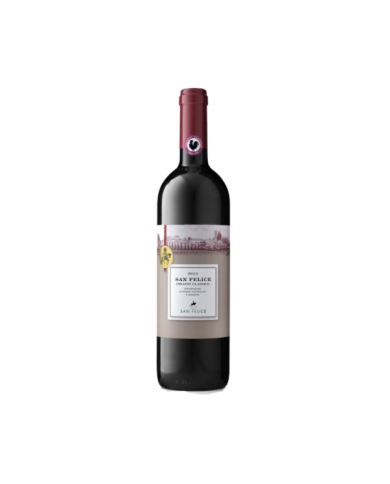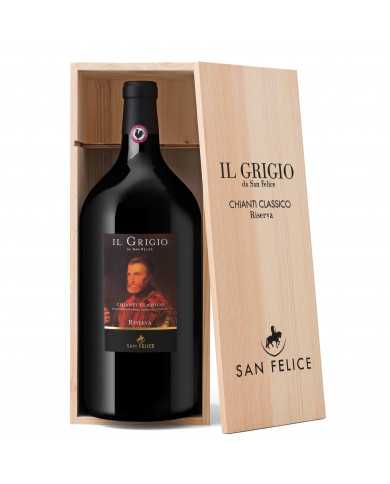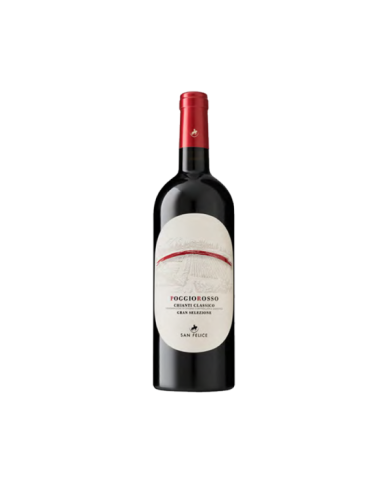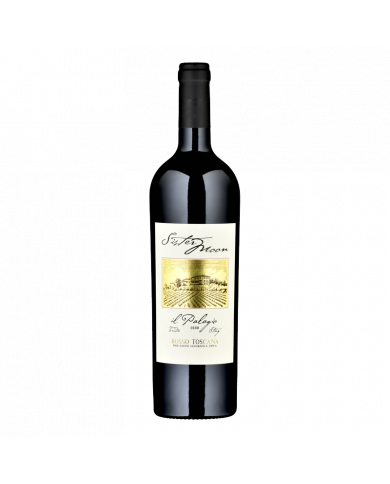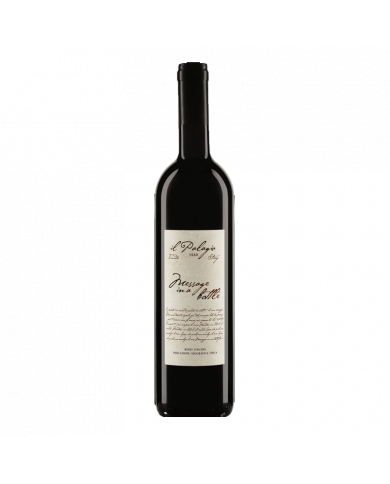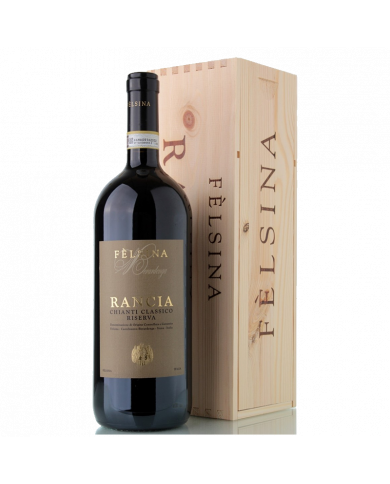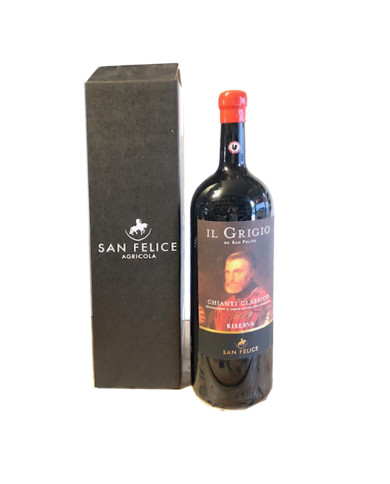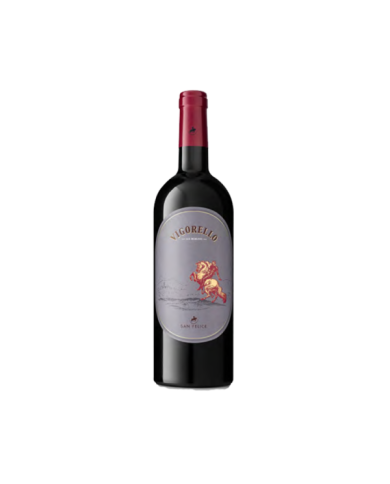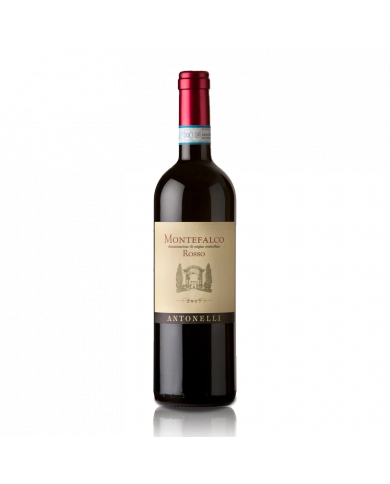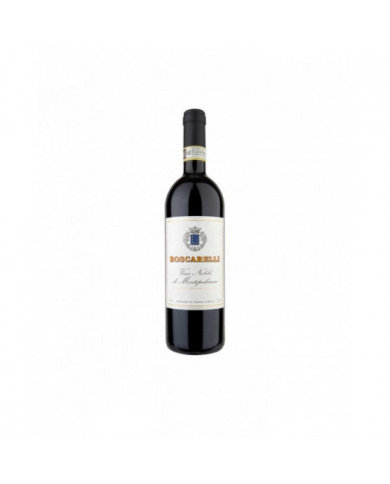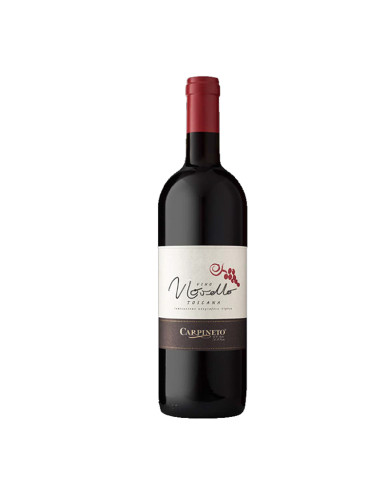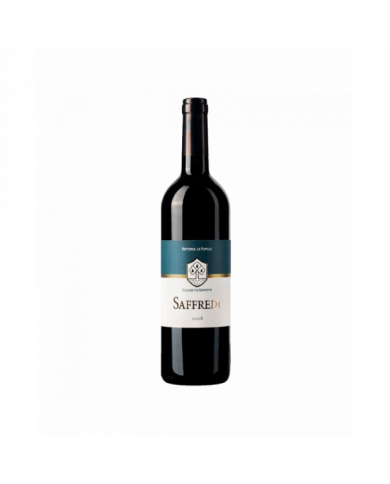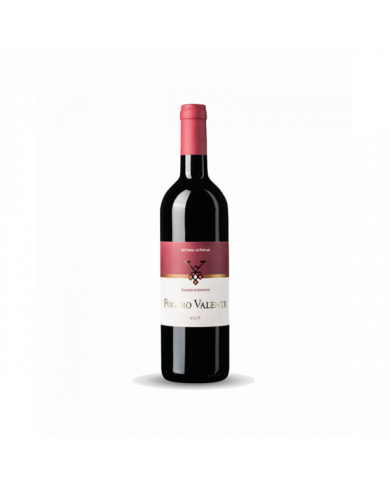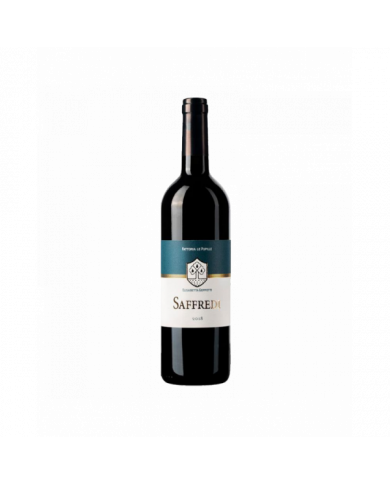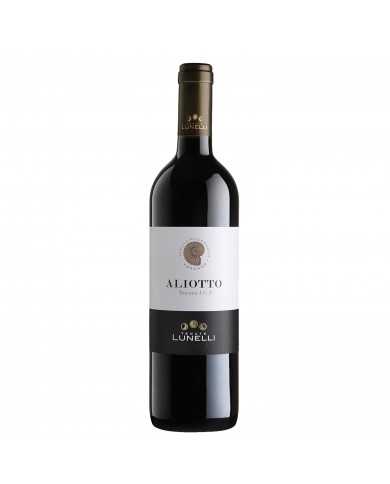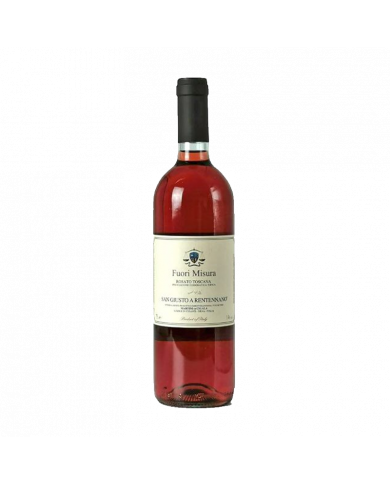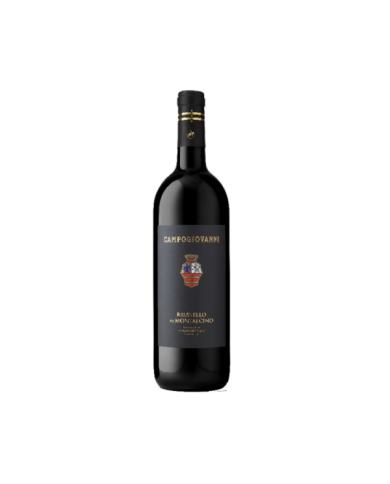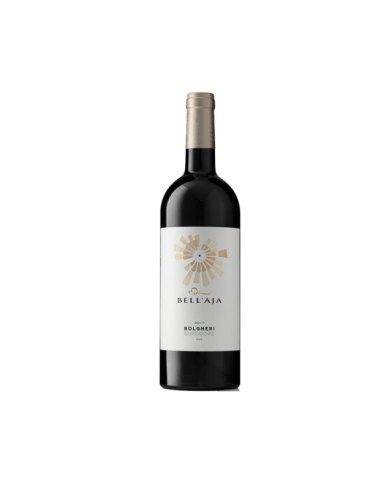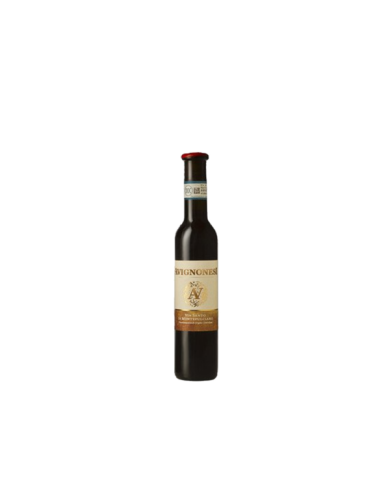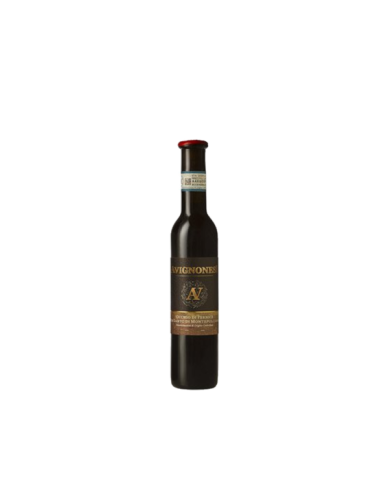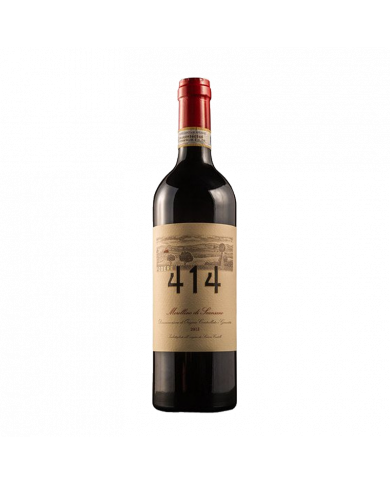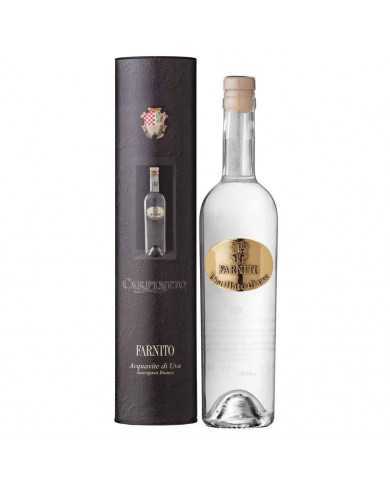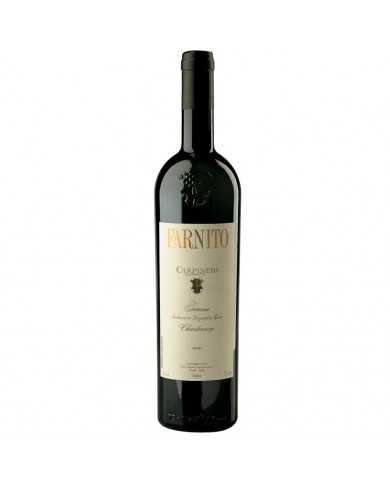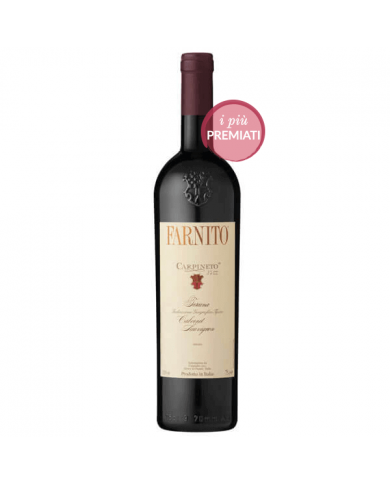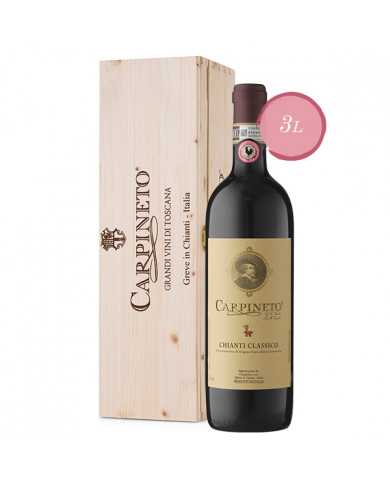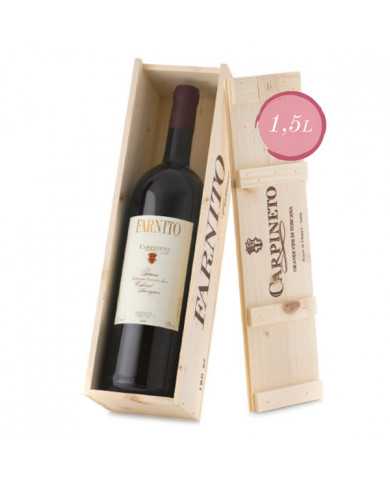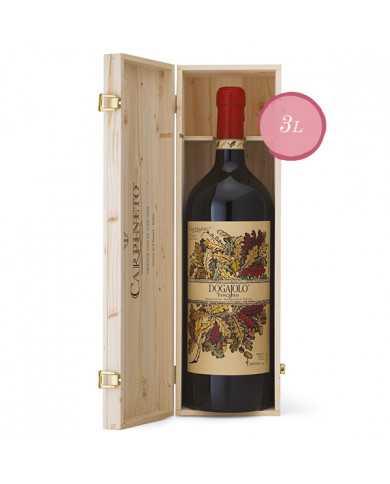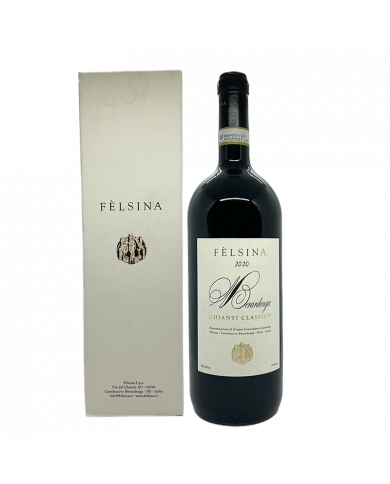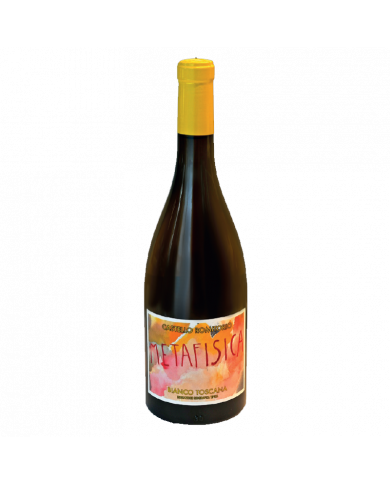It is not surprising to discover that this Chianti Riserva DOCG Tenuta di Campriano produced from Buccia Nera has been awarded several times by international wine critics. After all, it is clear that it is a great product from the first taste. It could be defined as pure Sangiovese, given that in the blending this grape weighs for about 85%. But in this case, to add nobility to the blend, a part of Merlot and one part of Cabernet Sauvignon are added, improving vines par excellence. The vinification of the grapes takes place in three different moments, always in steel at a controlled temperature. Spontaneous alcoholic and malolactic fermentation and 2-year aging in 30-hectolitre oak barrels followed by a further year in the bottle. The result is a complex and structured red. The color is impenetrable, ruby red with garnet reflections. The nose opens with notes of cherry in alcohol and blackberry, to then offer spicy sensations of chocolate, licorice and tobacco. In the mouth it is full, voluminous, soft at the entrance, with nice ripe tannins that leave the mouth dry and clean.
Both powerful and incredibly fine, the wine reveals mature and elegant tannins, exquisite fruitiness and exceptional length on the palate. Pleasant since its youth, it has the advantage of being able to be appreciated without waiting too long, while retaining a great aging potential, rare for an Italian wine of this level ... In short, we are facing a legendary bottle and words are not enough to describe its beauty.
Disturbing. If we had to describe this wine in one word, we would use this adjective and no other. The red blend, based on Cabernet Sauvignon and Merlot, is an intense amalgam of two vines that express themselves with great elegance and strength in this territory. We are at 350 meters above sea level, in a soil rich in clay and silt, ideal characteristics for the production of intense reds, with a complex organoleptic profile and great aging potential. Pa' Ro rosso immediately expresses itself in the glass with great personality: the color is an intense and impenetrable ruby red. A sense of smell that is very full of aromas and herbaceous notes is striking, the spiciness embellishes an already well-stressed nose with notes of black pepper and licorice. Scents of plum and blueberry define its fruitiness, while the balsamic note makes it vivid and powerful. At the sip it continues to seduce us for the fullness of the taste; enveloping softness and alcohol on one side, well balanced by good freshness and elegant tannins on the other. A fine wine, very intense, very long. All the cards are in order to achieve excellence. What better pairing than a sweet wild boar?
The destemmed grapes remain in maceration on the skins throughout the alcoholic fermentation. The alcoholic fermentation takes place entirely in stainless steel barrels at a controlled temperature of 18┬░C. AGING: In stainless steel for 8 months and in bottle for at least 2 months.
90% Sangiovese, with just a hint of Canaiolo to make the cut more intriguing. Thus Sassocupo was born, which bears the Chianti Superiore Denomination on the label and is distinguished by an alcohol content of 14 degrees. An extremely pleasant red, which can give great satisfaction at the table, especially if the menu includes a large use of red meats. If in the glass it has a beautiful, not too lively ruby red color, the nose reveals the unmistakable notes of ripe red fruit, such as cherry and black cherry, which soon give way to an evident hint of pepper. In the mouth it is vertical, with a nice tannin and a decisive freshness that make it elegant and versatile. Long persistence, leaves the mouth pleasantly clean and dry.
Cuv├®e of Cabernet Sauvignon, Merlot, Cabernet Franc and Petit Verdot, Ornellaia 2014 is capable of expressing all the exceptional qualities of the territory. 2014 was a particular year for Tenuta dell ' Ornellaia , with a particularly rainy August that threatened very difficult conditions for grape ripening and an increased risk of diseases for the vineyards. But it is in the dark moments that passion and experience can change the course of events: the continuous leaf stripping and treatments carried out during the summer have allowed the grapes to arrive safe and sound for the harvest.
Cuv├®e of Cabernet Sauvignon, Merlot, Cabernet Franc and Petit Verdot, Ornellaia 2014 is capable of expressing all the exceptional qualities of the territory. 2014 was a particular year for Tenuta dell ' Ornellaia , with a particularly rainy August that threatened very difficult conditions for grape ripening and an increased risk of diseases for the vineyards. But it is in the dark moments that passion and experience can change the course of events: the continuous leaf stripping and treatments carried out during the summer have allowed the grapes to arrive safe and sound for the harvest.
Cuv├®e of Cabernet Sauvignon, Merlot, Cabernet Franc and Petit Verdot, Ornellaia 2014 is capable of expressing all the exceptional qualities of the territory. 2014 was a particular year for Tenuta dell ' Ornellaia , with a particularly rainy August that threatened very difficult conditions for grape ripening and an increased risk of diseases for the vineyards. But it is in the dark moments that passion and experience can change the course of events: the continuous leaf stripping and treatments carried out during the summer have allowed the grapes to arrive safe and sound for the harvest.
Cuv├®e of Cabernet Sauvignon, Merlot, Cabernet Franc and Petit Verdot, Ornellaia 2014 is capable of expressing all the exceptional qualities of the territory. 2014 was a particular year for Tenuta dell ' Ornellaia , with a particularly rainy August that threatened very difficult conditions for grape ripening and an increased risk of diseases for the vineyards. But it is in the dark moments that passion and experience can change the course of events: the continuous leaf stripping and treatments carried out during the summer have allowed the grapes to arrive safe and sound for the harvest.
Cuv├®e of Cabernet Sauvignon, Merlot, Cabernet Franc and Petit Verdot, Ornellaia 2014 is capable of expressing all the exceptional qualities of the territory. 2014 was a particular year for Tenuta dell ' Ornellaia , with a particularly rainy August that threatened very difficult conditions for grape ripening and an increased risk of diseases for the vineyards. But it is in the dark moments that passion and experience can change the course of events: the continuous leaf stripping and treatments carried out during the summer have allowed the grapes to arrive safe and sound for the harvest.
Cuv├®e of Cabernet Sauvignon, Merlot, Cabernet Franc and Petit Verdot, Ornellaia 2014 is capable of expressing all the exceptional qualities of the territory. 2014 was a particular year for Tenuta dell ' Ornellaia , with a particularly rainy August that threatened very difficult conditions for grape ripening and an increased risk of diseases for the vineyards. But it is in the dark moments that passion and experience can change the course of events: the continuous leaf stripping and treatments carried out during the summer have allowed the grapes to arrive safe and sound for the harvest.
Intense ruby red and noble color. It has elegant fruity scents on the nose, of cherries, black cherries, black currants, blackberries and blueberries, which are enriched with tertiary tones of spices, coffee, licorice and oak. The taste is soft, luxuriant and persistent, expressive in the fruit and silky in the tannins. Long persistence and deep closure. Perfect in combination with the second dishes of the land cuisine, it goes very well with dishes based on noble poultry or feathered game. Try it with the chicken in red wine.
Intense ruby red and noble color. It has elegant fruity scents on the nose, of cherries, black cherries, black currants, blackberries and blueberries, which are enriched with tertiary tones of spices, coffee, licorice and oak. The taste is soft, luxuriant and persistent, expressive in the fruit and silky in the tannins. Long persistence and deep closure. Perfect in combination with the second dishes of the land cuisine, it goes very well with dishes based on noble poultry or feathered game. Try it with the chicken in red wine.
Intense ruby red and noble color. It has elegant fruity scents on the nose, of cherries, black cherries, black currants, blackberries and blueberries, which are enriched with tertiary tones of spices, coffee, licorice and oak. The taste is soft, luxuriant and persistent, expressive in the fruit and silky in the tannins. Long persistence and deep closure. Perfect in combination with the second dishes of the land cuisine, it goes very well with dishes based on noble poultry or feathered game. Try it with the chicken in red wine.
Deep red, tending to garnet. Rich and complex bouquet, with sweet notes of plum, ripe cherry and small fruits that blend well with balsamic and tobacco notes. In the mouth you can immediately notice the great structure, full and soft, characterized by powerful tannins that give dimension while remaining gentle on the palate. A wine that lends itself to a very long aging. Throughout the meal, it is an ideal accompaniment to red meats, savory game and aged cheeses.
Deep red, tending to garnet. Rich and complex bouquet, with sweet notes of plum, ripe cherry and small fruits that blend well with balsamic and tobacco notes. In the mouth you can immediately notice the great structure, full and soft, characterized by powerful tannins that give dimension while remaining gentle on the palate. A wine that lends itself to a very long aging. Throughout the meal, it is an ideal accompaniment to red meats, savory game and aged cheeses.
Intense, deep color, with garnet reflections. The nose is complex, with sweet hints of licorice, coffee, plum jam, tobacco and a light note of violet. The structure is very elegant, large in size, with very soft tannins and perfectly balanced with a lively acidity, capable of sustaining its persistence for a long time. From great aging. For the whole meal, it superbly accompanies red meats, game and aged cheeses.
Intense, deep color, with garnet reflections. The nose is complex, with sweet hints of licorice, coffee, plum jam, tobacco and a light note of violet. The structure is very elegant, large in size, with very soft tannins and perfectly balanced with a lively acidity, capable of sustaining its persistence for a long time. From great aging. For the whole meal, it superbly accompanies red meats, game and aged cheeses.
Intense, deep color, with garnet reflections. The nose is complex, with sweet hints of licorice, coffee, plum jam, tobacco and a light note of violet. The structure is very elegant, large in size, with very soft tannins and perfectly balanced with a lively acidity, capable of sustaining its persistence for a long time. From great aging. For the whole meal, it superbly accompanies red meats, game and aged cheeses.
Produced for the first time in the 1977 vintage, it was the first pure Sangiovese vinified in our area of Radda in Chianti. The grapes come from our historic vineyards, planted between 1968 and 1999. It ages for one year in Allier barriques and one year in Slavonian oak barrels.
Produced for the first time in the 1977 vintage, it was the first pure Sangiovese vinified in our area of Radda in Chianti. The grapes come from our historic vineyards, planted between 1968 and 1999. It ages for one year in Allier barriques and one year in Slavonian oak barrels.
This fine wine from the Antinori winery respects the local traditions of Tuscany. The denomination is that of Vin Santo della Valdichiana DOC. Produced from the blended vinification of Tuscan Trebbiano and Malvasia vines.
The Vino Nobile di Montepulciano Santa Pia La Braccesca of the Marchesi Antinori was born in the homonymous estate, located on the Sienese hills. It is produced exclusively with Prugnolo Gentile grapes, harvested only by hand during the month of September. Fermentation takes place in stainless steel tanks at a controlled temperature of 28 ┬░ C for 20 days. Subsequently the wine is aged in barrique for 15 months and for another 20 months in the bottle before being put on the market.
Dense ruby color with garnet reflections. The nose expands sensations of plum, mulberry, violet, and then unraveling on wild and licorice tones. In the mouth, warm and enveloping, it declines sumptuous softness and caressing tannins. Ideal together with the silverside with mustard and plums or on the stuffed roast in a crust.
Dense ruby color with garnet reflections. The nose expands sensations of plum, mulberry, violet, and then unraveling on wild and licorice tones. In the mouth, warm and enveloping, it declines sumptuous softness and caressing tannins. Ideal together with the silverside with mustard and plums or on the stuffed roast in a crust.
Dense ruby color with garnet reflections. The nose expands sensations of plum, mulberry, violet, and then unraveling on wild and licorice tones. In the mouth, warm and enveloping, it declines sumptuous softness and caressing tannins. Ideal together with the silverside with mustard and plums or on the stuffed roast in a crust.
The Chianti Classico "Badia a Passignano" is a famous and intense expression of the Chianti of the Marchesi Antinori . It is a full-bodied and complex red wine, with the unmistakable aromas of berries, cherries and sweet spices. Aged for 14 months in oak barrels
Historic Antinori house wine which, since the 2011 vintage, is produced with grapes from the Tignanello estate. It is composed almost entirely of Sangiovese grapes combined with a small amount of other complementary varieties. A wine that presents itself as the full expression of the quality and elegance of the Sangiovese of these areas.
Ruby mantle tending to garnet. On the nose, sensations of violet, berries and plum follow one another in sequence, then black pepper, pleasant mentholated touches and sensations of leather and chocolate. In the mouth it expresses vigor and roundness, with tannins of excellent caliber that anticipate a very long finish. Ideal with delicious stuffed meats such as quail or pigeon.
Ruby mantle tending to garnet. On the nose, sensations of violet, berries and plum follow one another in sequence, then black pepper, pleasant mentholated touches and sensations of leather and chocolate. In the mouth it expresses vigor and roundness, with tannins of excellent caliber that anticipate a very long finish. Ideal with delicious stuffed meats such as quail or pigeon.
Ruby mantle tending to garnet. On the nose, sensations of violet, berries and plum follow one another in sequence, then black pepper, pleasant mentholated touches and sensations of leather and chocolate. In the mouth it expresses vigor and roundness, with tannins of excellent caliber that anticipate a very long finish. Ideal with delicious stuffed meats such as quail or pigeon.
Ruby mantle tending to garnet. On the nose, sensations of violet, berries and plum follow one another in sequence, then black pepper, pleasant mentholated touches and sensations of leather and chocolate. In the mouth it expresses vigor and roundness, with tannins of excellent caliber that anticipate a very long finish. Ideal with delicious stuffed meats such as quail or pigeon.
Intense ruby red, the nose perceives intense warm notes of ripe red fruit and spices accompanied by deep floral notes. On the palate it is persuasive, rich, enveloping and sweet thanks to the presence of ready, thick and soft tannins. The balance between freshness and body contributes to an excellent expression in the flavor and to a long and extremely pleasant persistence of taste.
Intense ruby red, the nose perceives intense warm notes of ripe red fruit and spices accompanied by deep floral notes. On the palate it is persuasive, rich, enveloping and sweet thanks to the presence of ready, thick and soft tannins. The balance between freshness and body contributes to an excellent expression in the flavor and to a long and extremely pleasant persistence of taste.
Intense ruby red, the nose perceives intense warm notes of ripe red fruit and spices accompanied by deep floral notes. On the palate it is persuasive, rich, enveloping and sweet thanks to the presence of ready, thick and soft tannins. The balance between freshness and body contributes to an excellent expression in the flavor and to a long and extremely pleasant persistence of taste.
Powerful and very balanced, it presents itself to the eye with a compact ruby color. The nose shows elegant sensations of ripe blackberry, oriental spices, wild flowers, pink pepper, white chocolate, leather and rhubarb. In the mouth it is balanced to the micron, with a powerful caloric note adequately balanced by fresh-savory stitching. The tannins, as expected, are tapered and stretch up to the very long finish dominated by sweet spices. Ideal with important meats such as thrush in truffle sauce or venison with juniper.
Powerful and very balanced, it presents itself to the eye with a compact ruby color. The nose shows elegant sensations of ripe blackberry, oriental spices, wild flowers, pink pepper, white chocolate, leather and rhubarb. In the mouth it is balanced to the micron, with a powerful caloric note adequately balanced by fresh-savory stitching. The tannins, as expected, are tapered and stretch up to the very long finish dominated by sweet spices. Ideal with important meats such as thrush in truffle sauce or venison with juniper.
Powerful and very balanced, it presents itself to the eye with a compact ruby color. The nose shows elegant sensations of ripe blackberry, oriental spices, wild flowers, pink pepper, white chocolate, leather and rhubarb. In the mouth it is balanced to the micron, with a powerful caloric note adequately balanced by fresh-savory stitching. The tannins, as expected, are tapered and stretch up to the very long finish dominated by sweet spices. Ideal with important meats such as thrush in truffle sauce or venison with juniper.
Powerful and very balanced, it presents itself to the eye with a compact ruby color. The nose shows elegant sensations of ripe blackberry, oriental spices, wild flowers, pink pepper, white chocolate, leather and rhubarb. In the mouth it is balanced to the micron, with a powerful caloric note adequately balanced by fresh-savory stitching. The tannins, as expected, are tapered and stretch up to the very long finish dominated by sweet spices. Ideal with important meats such as thrush in truffle sauce or venison with juniper.
Guado al Tasso Bolgheri Superiore is the symbolic wine of the Estate and one of the best wines produced by Antinori , it is a powerful red wine, extremely elegant and rich in exceptional balsamic notes and ripe fruit. It is composed of 5% Cabernet Franc, 50% Cabernet Sauvignon, 45% Merlot grown in the best vineyards of the estate.
Guado al Tasso Bolgheri Superiore is the symbolic wine of the Estate and one of the best wines produced by Antinori , it is a powerful red wine, extremely elegant and rich in exceptional balsamic notes and ripe fruit. It is composed of 5% Cabernet Franc, 50% Cabernet Sauvignon, 45% Merlot grown in the best vineyards of the estate.
Guado al Tasso Bolgheri Superiore is the symbolic wine of the Estate and one of the best wines produced by Antinori , it is a powerful red wine, extremely elegant and rich in exceptional balsamic notes and ripe fruit. It is composed of 5% Cabernet Franc, 50% Cabernet Sauvignon, 45% Merlot grown in the best vineyards of the estate.
Guado al Tasso Bolgheri Superiore is the symbolic wine of the Estate and one of the best wines produced by Antinori , it is a powerful red wine, extremely elegant and rich in exceptional balsamic notes and ripe fruit. It is composed of 5% Cabernet Franc, 50% Cabernet Sauvignon, 45% Merlot grown in the best vineyards of the estate.
Guado al Tasso Bolgheri Superiore is the symbolic wine of the Estate and one of the best wines produced by Antinori , it is a powerful red wine, extremely elegant and rich in exceptional balsamic notes and ripe fruit. It is composed of 5% Cabernet Franc, 50% Cabernet Sauvignon, 45% Merlot grown in the best vineyards of the estate.
Il Palagio is located above the picturesque Tuscan town of Figline Valdarno. For the last two decades it has been the summer home of Sting and Trudie's growing family and the site of many of their intimate parties, private concerts and anniversaries. The villa, its guest houses, vineyards and olive groves have been lovingly restored by Sting and Trudie and is now a fully functioning, living organic farm and vineyard.
Aqua Vitae Le Pergole Torte It is a product obtained by distillation with steam cauldrons from the dripping pomace of Sangiovese grapes from the harvest of the "Le Pergole Torte" vineyard, located at the Montevertine farm.
Produced for the first time in the 1977 vintage, it was the first pure Sangiovese vinified in our area of Radda in Chianti. The grapes come from our historic vineyards, planted between 1968 and 1999. It ages for one year in Allier barriques and one year in Slavonian oak barrels.
Produced for the first time in the 1977 vintage, it was the first pure Sangiovese vinified in our area of Radda in Chianti. The grapes come from our historic vineyards, planted between 1968 and 1999. It ages for one year in Allier barriques and one year in Slavonian oak barrels.
40 years after the acquisition of the Campogiovanni estate in Montalcino, San Felice 's interest has shifted to another area of Tuscan wine excellence: Bolgheri. Faithful to its philosophy of producing exclusively wines from proprietary grapes, 6 hectares of vineyards have been identified in Le Sondraie. The vines have an average age of 5 years and are planted on a silt-sandy soil typical of the area. The varieties are mainly Cabernet Sauvignon (2 ha) and Merlot (4 ha). Two wines are produced: Bolgheri and Bolgheri Superiore.
Produced exclusively in exceptional vintages, this Riserva represents for San Felice the maximum expression of the 'terroir' of Campogiovanni. Coming from the careful selection of Sangiovese grosso from the 'Il Quercione' vineyard of about 2.5 hectares, it is a wine that combines rigor, concentration, elegance as well as an extraordinary capacity for aging. Refine for 24 months in 500-liter French oak barrels. (tonneaux) and 36 months in the bottle.
Produced exclusively in exceptional vintages, this Riserva represents for San Felice the maximum expression of the 'terroir' of Campogiovanni. Coming from the careful selection of Sangiovese grosso from the 'Il Quercione' vineyard of about 2.5 hectares, it is a wine that combines rigor, concentration, elegance as well as an extraordinary capacity for aging. Refine for 24 months in 500-liter French oak barrels. (tonneaux) and 36 months in the bottle.
Traditional Vin Santo both in the blend, Trebbiano and Malvasia, and in the processing method. The grapes, harvested in early October, are dried on racks until December, and then softly squeezed. The must obtained ferments slowly and refines for 5 years in small oak barrels (kegs).
Produced entirely with native grapes, Sangiovese mainly with additions of Colorino and Pugnitello, it is a typical Chianti Classico, of medium structure, with a strong personality that stands out in particular for its elegance. The vinification takes place in the traditional way, with medium length maceration, followed by a maturation of the wine for 12 months in Slavonian oak barrels.
Produced entirely with native grapes, Sangiovese mainly with additions of Colorino and Pugnitello, it is a typical Chianti Classico, of medium structure, with a strong personality that stands out in particular for its elegance. The vinification takes place in the traditional way, with medium length maceration, followed by a maturation of the wine for 12 months in Slavonian oak barrels.
Produced entirely with native grapes, Sangiovese mainly with additions of Colorino and Pugnitello, it is a typical Chianti Classico, of medium structure, with a strong personality that stands out in particular for its elegance. The vinification takes place in the traditional way, with medium length maceration, followed by a maturation of the wine for 12 months in Slavonian oak barrels.
Produced entirely with native grapes, Sangiovese mainly with additions of Colorino and Pugnitello, it is a typical Chianti Classico, of medium structure, with a strong personality that stands out in particular for its elegance. The vinification takes place in the traditional way, with medium length maceration, followed by a maturation of the wine for 12 months in Slavonian oak barrels.
Only the best Sangiovese grapes selected in the company's Chianti Classico vineyards make up this Reserve, a valid combination of tradition and modernity. It ages for about 24 months in wood, of which a part (about 20%) in barriques, and one year in bottle. The label depicts a famous painting by Titian 'Man with armor'.
Only the best Sangiovese grapes selected in the company's Chianti Classico vineyards make up this Reserve, a valid combination of tradition and modernity. It ages for about 24 months in wood, of which a part (about 20%) in barriques, and one year in bottle. The label depicts a famous painting by Titian 'Man with armor'.
Only the best Sangiovese grapes selected in the company's Chianti Classico vineyards make up this Reserve, a valid combination of tradition and modernity. It ages for about 24 months in wood, of which a part (about 20%) in barriques, and one year in bottle. The label depicts a famous painting by Titian 'Man with armor'.
Only the best grapes selected in the company's Chianti Classico vineyards make up this Reserve, a valid combination of tradition and modernity. The label depicts a famous painting by Titian 'Man with armor'.
La Vigna Del Lago It can happen to come across unexpected places, the Vigna del Lago, as in this 100% Chardonnay, unexpected white single-vineyard and newcomer in the San Felice house of particular aromatic freshness and flavor, carefully selected grapes and soil with unique characteristics, on which traces of the ancient Etruscan presence remain.
Tradition and Future The first Supertuscan in Chianti Classico since 1968. It has an important history and today it stands out in the wine market of this category for a reason: it combines the tradition of international vines such as Cabernet and Merlot with the inclusion of a native variety, il Pugnitello, which is unique to San Felice .
Already towards the end of the 70s, in the locality of Poggio Rosso, some selected clones of Sangiovese were planted several times. Poggio Rosso is the result of a careful selection of this grape from some plots of the vineyard of the same name and today represents the excellence of the San Felice terroir. Wine of great concentration and elegance, produced in limited quantities and, especially in the best vintages, it ages for about 20 months in 500-liter tonneaux and another 12 months in the bottle.
Named after Sting's song "Sister Moon", this was the first Tuscan IGT wine produced at the Palagio. With an alcohol content of 14.9% it ages for 24 months in new French barriques.
Message in a Bottle now joins our acclaimed wine portfolio. A versatile and highly drinkable Tuscan IGT wine, it goes well with many dishes. With an alcohol content of 13.2% it is aged for 12 months in French oak barrels.
Fontalloro della Fattoria di Felsina is a Tuscan red wine based on Sangiovese, considered an unmistakable territorial brand. The complex aromatic profile is drawn by dark shades of blackberry, licorice and black pepper with light hints of tobacco. The body is powerful and structured, with well integrated tannins and a finish with a pleasant aftertaste.
Fontalloro della Fattoria di Felsina is a Tuscan red wine based on Sangiovese, considered an unmistakable territorial brand. The complex aromatic profile is drawn by dark shades of blackberry, licorice and black pepper with light hints of tobacco. The body is powerful and structured, with well integrated tannins and a finish with a pleasant aftertaste.
Fontalloro della Fattoria di Felsina is a Tuscan red wine based on Sangiovese, considered an unmistakable territorial brand. The complex aromatic profile is drawn by dark shades of blackberry, licorice and black pepper with light hints of tobacco. The body is powerful and structured, with well integrated tannins and a finish with a pleasant aftertaste.
Fontalloro della Fattoria di Felsina is a Tuscan red wine based on Sangiovese, considered an unmistakable territorial brand. The complex aromatic profile is drawn by dark shades of blackberry, licorice and black pepper with light hints of tobacco. The body is powerful and structured, with well integrated tannins and a finish with a pleasant aftertaste.
Fontalloro della Fattoria di Felsina is a Tuscan red wine based on Sangiovese, considered an unmistakable territorial brand. The complex aromatic profile is drawn by dark shades of blackberry, licorice and black pepper with light hints of tobacco. The body is powerful and structured, with well integrated tannins and a finish with a pleasant aftertaste.
Fontalloro della Fattoria di Felsina is a Tuscan red wine based on Sangiovese, considered an unmistakable territorial brand. The complex aromatic profile is drawn by dark shades of blackberry, licorice and black pepper with light hints of tobacco. The body is powerful and structured, with well integrated tannins and a finish with a pleasant aftertaste.
The Rancia vineyard takes its name from the ancient farm that stands next to a pre-existing Benedictine monastery.
The Rancia vineyard takes its name from the ancient farm that stands next to a pre-existing Benedictine monastery.
The Rancia vineyard takes its name from the ancient farm that stands next to a pre-existing Benedictine monastery.
The Rancia vineyard takes its name from the ancient farm that stands next to a pre-existing Benedictine monastery.
The Rancia vineyard takes its name from the ancient farm that stands next to a pre-existing Benedictine monastery.
Chianti Classico, 100% Sangiovese from Castelnuovo Berardenga, produced for the first time in 1967. Extremely heterogeneous soils, mirror of the territory, the vineyards develop with south-west exposure at about 320-420 m slm where the wind makes itself felt. The higher ground is rich above all in quartz sandstone, while the land bordering the Colli Senesi area is rich in stratiform sandstone and silt. Since the vineyards are located at different altitudes, the harvest is done at different times but in any case within the first 3 weeks of October.
Chianti Classico, 100% Sangiovese from Castelnuovo Berardenga, produced for the first time in 1967. Extremely heterogeneous soils, mirror of the territory, the vineyards develop with south-west exposure at about 320-420 m slm where the wind makes itself felt. The higher ground is rich above all in quartz sandstone, while the land bordering the Colli Senesi area is rich in stratiform sandstone and silt. Since the vineyards are located at different altitudes, the harvest is done at different times but in any case within the first 3 weeks of October.
The vineyards are located in Castelnuovo Berardenga, in the south-eastern part of the Chianti Classico production area, north-east of Siena.
The vineyards are located in Castelnuovo Berardenga, in the south-eastern part of the Chianti Classico production area, north-east of Siena.
The Grigio Gran Selezione, 80% Sangiovese enriched with ancient indigenous varieties such as Abrusco, Pugnitello, Black Malvasia, Ciliegiolo and Mazzese, is born only from our most suitable soils, which contribute to the complexity of the wine, keeping intact the elegance and expression of the terroir of San Felice .
The Grigio Gran Selezione, 80% Sangiovese enriched with ancient indigenous varieties such as Abrusco, Pugnitello, Black Malvasia, Ciliegiolo and Mazzese, is born only from our most suitable soils, which contribute to the complexity of the wine, keeping intact the elegance and expression of the terroir of San Felice .
Witness of an environment that is still uncontaminated and unchanged over time, cradle of breathtaking landscapes, Faunae expresses the essence of Chianti Classico, respecting its territory.
The Grigio Gran Selezione, 80% Sangiovese enriched with ancient indigenous varieties such as Abrusco, Pugnitello, Black Malvasia, Ciliegiolo and Mazzese, is born only from our most suitable soils, which contribute to the complexity of the wine, keeping intact the elegance and expression of the terroir of San Felice .
The Grigio Gran Selezione, 80% Sangiovese enriched with ancient indigenous varieties such as Abrusco, Pugnitello, Black Malvasia, Ciliegiolo and Mazzese, is born only from our most suitable soils, which contribute to the complexity of the wine, keeping intact the elegance and expression of the terroir of San Felice .
The Grigio Gran Selezione, 80% Sangiovese enriched with ancient indigenous varieties such as Abrusco, Pugnitello, Black Malvasia, Ciliegiolo and Mazzese, is born only from our most suitable soils, which contribute to the complexity of the wine, keeping intact the elegance and expression of the terroir of San Felice .
The Grigio Gran Selezione, 80% Sangiovese enriched with ancient indigenous varieties such as Abrusco, Pugnitello, Black Malvasia, Ciliegiolo and Mazzese, is born only from our most suitable soils, which contribute to the complexity of the wine, keeping intact the elegance and expression of the terroir of San Felice .
The Le Ragnaie farm covers an area of 28 hectares in the municipality of Montalcino, in the province of Siena. Our lands are cultivated with vineyards and olive groves, following the dictates of organic farming and are located in three distinct areas of the Montalcino area, allowing us to vinify grapes from three different terroirs.
The 5 hectares used for the production of Brunello, facing south-west towards the sea and surrounded by uncultivated woods, boast over 40-year-old vines and are cultivated according to the dictates of organic agriculture.
The 5 hectares used for the production of Brunello, facing south-west towards the sea and surrounded by uncultivated woods, boast over 40-year-old vines and are cultivated according to the dictates of organic agriculture.
Ciacci Piccolomini D'aragona Riserva Santa Caterina d'Oro is a "still red" wine produced by Ciacci Piccolomini D'aragona in Tuscany.
Tradition and Future The first Supertuscan in Chianti Classico since 1968. It has an important history and today it stands out in the wine market of this category for a reason: it combines the tradition of international vines such as Cabernet and Merlot with the inclusion of a native variety, il Pugnitello, which is a unicum of San Felice .
Traditional wine obtained from the assembly of Sangiovese and the typical grape of Montefalco, as well as other red grape varieties.
Produced exclusively in exceptional vintages, this Riserva represents for San Felice the maximum expression of the 'terroir' of Campogiovanni. Coming from the careful selection of Sangiovese grosso from the 'Il Quercione' vineyard of about 2.5 hectares, it is a wine that combines rigor, concentration, elegance as well as an extraordinary capacity for aging. Refine for 24 months in 500-liter French oak barrels. (tonneaux) and 36 months in the bottle.
Novello wine is the first product to be consumed from the harvest. However, by novello we do not mean only the new wine of the vintage, but the wine produced with particular techniques, designed to give those peculiar aromas and those characteristics of softness and roundness that make it suitable for immediate consumption.
Saffredi is a robust, rich and complex Supertuscan, produced with a Bordeaux blend and aged in barriques for 18 months. Ample and intense hints of berries, spices and balsamic herbs emerge from a round and velvety texture, of great balance and persistence: an exuberant expression of the Tuscan Maremma
Compact ruby red. The bouquet reveals the fragrance of red roses, black cherry, blood orange and blackberry. Followed by juniper berries, dried flowers, Tuscan cigars and undergrowth. The tannins are dense and silky which develop on a fresh and savory base. Persistent finish on blackcurrant echoes.
Saffredi is a robust, rich and complex Supertuscan, produced with a Bordeaux blend and aged in barriques for 18 months. Ample and intense hints of berries, spices and balsamic herbs emerge from a round and velvety texture, of great balance and persistence: an exuberant expression of the Tuscan Maremma
The Toscana Rosso Aliotto of Tenute Lunelli was born in vineyards located in the Podernovo estate, in the municipality of Terricciola, in the extraordinary terroir of the Pisan hills.
Yield per vine 1 kg, harvest 25-28 September. The wine is obtained by extracting the must from the Chianti Classico, Riserva, Percarlo, Ricolma tanks within 12-24 hours of placing the grapes, and partly with grapes (Merlot, Sangiovese, Canaiolo) harvested early and vinified in white. Slow fermentation at a temperature below 23┬░C, with the addition of about 15% of de-stemmed grapes. Maturation for 5 months in steel. The wine is subjected to light filtering, so it may have natural sediment. 8,200 bottles bottled on March 20th. Organic wine.
Only the best Sangiovese grapes selected in the company's Chianti Classico vineyards make up this Reserve, a valid combination of tradition and modernity. It ages for about 24 months in wood, of which a part (about 20%) in barriques, and one year in bottle. The label depicts a famous painting by Titian 'Man with armor'.
Tradition and Future The first Supertuscan in Chianti Classico since 1968. It has an important history and today it stands out in the wine market of this category for a reason: it combines the tradition of international vines such as Cabernet and Merlot with the inclusion of a native variety, il Pugnitello, which is unique to San Felice .
The Beauty of Excellence \ nThe top of the range of San Felice , a trip to Tuscany with your eyes closed. \ nSangiovese in purity is the first Cru from a single vineyard that is born right in front of the village of San Felice in Chianti Classico. Award-winning, it is a must have.
The Beauty of Excellence \ nThe top of the range of San Felice , a trip to Tuscany with your eyes closed. \ nSangiovese in purity is the first Cru from a single vineyard that is born right in front of the village of San Felice in Chianti Classico. Award-winning, it is a must have.
The Campogiovanni vineyards are located on the southern slope of Montalcino, an area where a particular microclimate and the composition of the soil create an ideal combination for a perfect ripening of Sangiovese grosso. Campogiovanni is a traditional style Brunello, aged on average three years in Slavonian oak barrels and 500-liter tonneaux and 12 months in bottle. It stands out for its finesse and longevity.
In the second half of the 1990s, 6 hectares of Rosso di Montalcino DOC vineyards were planted on the Campogiovanni estate. This wine demonstrates the great versatility of Sangiovese capable of expressing itself at excellent levels even in a less structured and complex version of Brunello. It is aged for 12 months in Slavonian oak barrels and stands out for its harmony, elegance in the aromas and pleasantness of drinking.
The Campogiovanni vineyards are located on the southern slope of Montalcino, an area where a particular microclimate and the composition of the soil create an ideal combination for a perfect ripening of Sangiovese grosso. Campogiovanni is a traditional style Brunello, aged on average three years in Slavonian oak barrels and 500-liter tonneaux and 12 months in bottle. It stands out for its finesse and longevity.
The sea in your mouth | the charm of infinity A young but highly prestigious label that we are presenting this year. The vineyard is located in Bolgheri, near the avenue of cypresses of Carducci and the sea, a very suggestive and fascinating place. Deep ruby red in color, the wine has hints of ripe fruit on the nose, with spicy notes of licorice and cocoa. On the palate it is full, dense, with silky and enveloping tannins.
Avignonesi 's Vin Santo di Montepulciano is a sweet wine of great elegance obtained from Malvasia and Trebbiano and aged for 10 years in casks. The nose releases intense aromas of caramel, chocolate, honey, orange peel and Mediterranean herbs. The taste is rich and enveloping with notes of figs, almonds, lemon and coffee
Avignonesi 's Vin Santo Occhio di Pernice is an extraordinarily rich sweet wine, produced from Sangiovese grapes and aged for 10 years in kegs. It exudes aromas of dates, dried fruit, panforte and sweet spices. On the palate it is sweet and sensual, infinite, with notes of cedar, salty candies and freshly baked biscuits
This selection of chardonnay, sauvignon blanc and semillon grapes is the demonstration of how an excellent white wine can also be produced in a territory more traditionally suited to the production of red grapes. Chardonnay, harvested when fully ripe, brings structure and complexity to the Sauvignon freshness and acidity. The small French oak barrels, where part of the wine ferments and ages for about 9 months, give it a pleasant and discreet toasted note.
This selection of chardonnay, sauvignon blanc and semillon grapes is the demonstration of how an excellent white wine can also be produced in a territory more traditionally suited to the production of red grapes. Chardonnay, harvested when fully ripe, brings structure and complexity to the Sauvignon freshness and acidity. The small French oak barrels, where part of the wine ferments and ages for about 9 months, give it a pleasant and discreet toasted note.
Morellino di Scansano del Podere 414 is a medium-bodied, soft and fresh red wine, aged for 12 months in wood. The notes of red fruit and sweet spices integrate with the fine and smooth tannins in a balanced and expressive structure, with good intensity and persistence
Morellino di Scansano del Podere 414 is a medium-bodied, soft and fresh red wine, aged for 12 months in wood. The notes of red fruit and sweet spices integrate with the fine and smooth tannins in a balanced and expressive structure, with good intensity and persistence
Morellino di Scansano del Podere 414 is a medium-bodied, soft and fresh red wine, aged for 12 months in wood. The notes of red fruit and sweet spices integrate with the fine and smooth tannins in a balanced and expressive structure, with good intensity and persistence
0. The grapes selected for this Riserva come from a single vineyard, the Vigna Alta volta sud at an altitude of 500m. Guides such as Gambero Rosso, Vini d'Italia, Decanter and Wine Spectator have awarded Nittardi Riserva with the highest scores, confirming that it is one of the best wines in Italy.
Vigna Doghessa is one of the most precious vineyards of the Nittardi vineyard park. Located at 450 meters above sea level, its Sangiovese vines that sink their roots into a soil rich in marl and alberese, look south-east to the village of Panzano.
Dogajolo is certainly one of the most innovative wines produced today and we, as Azienda Carpineto, have the honor of having created it. All those characteristics that are most appreciated in wine are enclosed in him: the strength of youth, the maturity of the wood, the softness of the class, the fruity and fragrant aromas, the lively and deep colors.
Chianti Classico Riserva is produced exclusively in the oldest wine-growing area of Tuscany, in a landscape of breathtaking beauty.
The Carpineto Estate, in Montalcino, rises at an altitude that reaches over 500 meters slm , one of the highest points within the denomination. The structure of the soil is made up of marl and accumulations of clay dating back to the Eocene (15 million years ago). The vineyards are surrounded by thick Mediterranean scrub which protects them from the humid western currents coming from the Maremma; it is also thanks to their exposure that the wine reveals hints of berries and Mediterranean herbs. A truly unique microclimate, which gives the wines aromatic intensity, lively acidity and marked elegance, as well as incredible longevity.
Grapes from our 2-hectare cru located in Dudda, Greve in Chianti, in one of the cooler areas of the denomination, particularly suitable for the production of a wine of great breed, depth and longevity.
Produced in the historic territory of Montepulciano (Siena), at an altitude of about 250 m above sea level.
Vino Nobile di Montepulciano Riserva 2010 / 2011 / 2013. Three great vintages for an exceptional collection, a unique triptych in the history of the Denomination.
Obtained from fully ripe grapes from a vineyard located on the hills of the Valdarno. The must is macerated with its skins at a low temperature and is subsequently processed fresh from fermentation in an artisanal distillery not far from the cellar.
Great red wine. It takes its name from Montepulciano, a Renaissance city in the province of Siena which dominates the wide and verdant Valdichiana from the top of a hill. The appellation of "Nobile" seems to derive not only from its intrinsic qualities of finesse and elegance, but also from the fact that in the past the production of this wine was particularly cared for by the noble families of the city.
Great red wine. It takes its name from Montepulciano, a Renaissance city in the province of Siena which dominates the wide and verdant Valdichiana from the top of a hill. The appellation of "Nobile" seems to derive not only from its intrinsic qualities of finesse and elegance, but also from the fact that in the past the production of this wine was particularly cared for by the noble families of the city.
A great red wine, it takes its name from Montepulciano, a Renaissance city in the province of Siena, which dominates the wide and verdant Valdichiana from the top of a hill. The appellation of "Nobile" seems to derive not only from its intrinsic qualities of finesse and elegance, but also from the fact that in the past the production of this wine was particularly cared for by the noble families of the city.
Obtained from ŌĆ£muscatŌĆØ aromatic quality grape juice, this sparkling wine aims to obtain the best balance between the varietal characteristics of the grape, the fruity aromas and the pleasantness of the residual sugar.
The product is very limited, from a small cuv├®e equal to a few thousand bottles.
We have been producers of sparkling wine since 1982 thanks to the construction of a plant, the first in the Chianti Classico area.
The Carpineto Estate, in Montalcino, rises at an altitude that reaches over 500 meters slm , one of the highest points within the denomination. The structure of the soil is made up of marl and accumulations of clay dating back to the Eocene (15 million years ago). The vineyards are surrounded by thick Mediterranean scrub which protects them from the humid western currents coming from the Maremma; it is also thanks to their exposure that the wine reveals hints of berries and Mediterranean herbs. A truly unique microclimate, which gives the wines aromatic intensity, lively acidity and marked elegance, as well as incredible longevity.
Tuscan VinsantoŌĆ” a wine whose origins are lost in the mists of time. Vinsanto in Tuscany is such an important wine full of meaning that it was difficult to buy, it was an ambition to make it at home with your own hands; in every family there was a person in charge of this art, usually the father or grandfather. The hypothesized origins of this exquisite drink, as well as those of its singular name are different and are lost in the mists of time. A Sienese legend says that in the 14th century a friar distributed a wine that healed the sick, hence the belief that it was a miraculous wine, "Santo". However, it cannot be excluded that the name "holy" derives from the use that has always been made of it during Mass.
Camponibbio is a large vineyard located at high density located in the southern part of our company of Chianciano in the province of Siena. It is divided into nine plots in which different vines are grown in different clones. Each harvest, the grapes of the varieties that have responded best to the seasonal trend are chosen. The blend essentially, made up of Sangiovese, Cabernet Sauvignon and Merlot, varies year by year, in percentages and varieties.
Camponibbio is a large vineyard located at high density located in the southern part of our company of Chianciano in the province of Siena. It is divided into nine plots in which different vines are grown in different clones. Each harvest, the grapes of the varieties that have responded best to the seasonal trend are chosen. The blend essentially, made up of Sangiovese, Cabernet Sauvignon and Merlot, varies year by year, in percentages and varieties.
From the vineyard of our "Valcolomba" estate, set in the characteristic Maremma area not far from the sea, comes this wine with a marked typicality. The intense colour, the wide olfactory bouquet, the important depth, the softness and the balance, define the contours of its great elegance.
Produced from grapes from our vineyards on our Chianciano/Montepulciano estate at an altitude of 300 meters above sea level.
Produced with grapes from vineyards of the companies of Gaville (Florence) and Chianciano/Montepulciano (Siena), the latter planted at high density and considered by us to be particularly happy and suitable for producing great wines.
Obtained from Chardonnay wines, chosen from the production of different vintages, the oldest of which were kept in fine oak barrels. This singular sparkling wine is produced in very limited quantities, being the result of a long selection.
This is certainly the best known Italian wine in the world and is produced in Central Tuscany.
"Mediterranean", this is the character of Vermentino produced in Maremma. The terroir strongly defines its organoleptic profile, merging all its aspects with the features of this wonderful land.
It is the result of a careful zoning study, conducted in our company in Chianciano, aimed at identifying the soils with the most suitable characteristics for the cultivation of the white grape varieties that make up this wine.
It is the result of a selection of grapes from Central Tuscany; Dogajolo Rosato is an elegant and structured product, with fruity and lively floral notes, essential characteristics for a young, innovative and easy to taste wine.
This is certainly one of the most innovative wines produced to date. It contains all those characteristics that are most appreciated in wine: the fruity and fragrant aromas, the lively and deep colours, the strength of youth, the maturity of the wood, the softness of elegance.
This is certainly one of the most innovative wines produced to date. It contains all those characteristics that are most appreciated in wine: the fruity and fragrant aromas, the lively and deep colours, the strength of youth, the maturity of the wood, the softness of elegance.
Chianti Classico Riserva is produced exclusively in the oldest wine-growing area of Tuscany, in a landscape of breathtaking beauty.
Produced with grapes from vineyards of the companies of Gaville (Florence) and Chianciano/Montepulciano (Siena), the latter planted at high density and considered by us to be particularly happy and suitable for producing great wines.
The Carpineto Estate, in Montalcino, rises at an altitude that reaches over 500 meters slm , one of the highest points within the denomination. The structure of the soil is made up of marl and accumulations of clay dating back to the Eocene (15 million years ago). The vineyards are surrounded by thick Mediterranean scrub which protects them from the humid western currents coming from the Maremma; it is also thanks to their exposure that the wine reveals hints of berries and Mediterranean herbs. A truly unique microclimate, which gives the wines aromatic intensity, lively acidity and marked elegance, as well as incredible longevity.
Produced in the oldest production area, as stated in the disciplinary that regulates it, this area gave its name to the wine and is the only one where Chianti Classico is produced. It extends between Florence and Siena in a territory of breathtaking beauty, made up of villages perched on the top of the hills, of olive trees cultivated in steep fields with an irregular outline and of cypresses lined up to delimit the innumerable dirt roads.
Produced in the oldest production area, as stated in the disciplinary that regulates it, this area gave its name to the wine and is the only one where Chianti Classico is produced. It extends between Florence and Siena in a territory of breathtaking beauty, made up of villages perched on the top of the hills, of olive trees cultivated in steep fields with an irregular outline and of cypresses lined up to delimit the innumerable dirt roads.
Produced in the oldest production area, as stated in the disciplinary that regulates it, this area gave its name to the wine and is the only one where Chianti Classico is produced. It extends between Florence and Siena in a territory of breathtaking beauty, made up of villages perched on the top of the hills, of olive trees cultivated in steep fields with an irregular outline and of cypresses lined up to delimit the innumerable dirt roads.
This is certainly one of the most innovative wines produced to date. It contains all those characteristics that are most appreciated in wine: the fruity and fragrant aromas, the lively and deep colours, the strength of youth, the maturity of the wood, the softness of elegance.
Tradition and Future The first Supertuscan in Chianti Classico since 1968. It has an important history and today it stands out in the wine market of this category for a reason: it combines the tradition of international vines such as Cabernet and Merlot with the inclusion of a native variety, il Pugnitello, which is unique to San Felice .
The Castello del Terriccio Toscana Rosso IGT is a red wine produced by Castello del Terriccio company. The style with which this wine is made makes it particularly interesting. It is obtained from a blend of: Syrah for 50%, Petit Verdot for 25% and for the remaining 25% from an original mix of native red berried grapes. All the grapes are rigorously vinified separately, after being carefully selected and harvested by hand.
Li├╣ is a red wine produced from 100% Merlot grapes. It is inspired by principles of purity of variety, of slenderness and substance that comes from the young harvest still combined, however, with an expression of substance. The expansion and freshness of the soils, in fact, guarantee a gradual and progressive ripening of the grapes even in the hottest years and the rigor of good agronomic practices. The average production is 6000 bottles
Li├╣ is a red wine produced from 100% Merlot grapes. It is inspired by principles of purity of variety, of slenderness and substance that comes from the young harvest still combined, however, with an expression of substance. The expansion and freshness of the soils, in fact, guarantee a gradual and progressive ripening of the grapes even in the hottest years and the rigor of good agronomic practices. The average production is 6000 bottles
The vineyards are located in Castelnuovo Berardenga, in the south-eastern part of the Chianti Classico production area, north-east of Siena.
Handcrafted grappa obtained by steam distillation in a discontinuous still using fresh pomace selected in Felsina. Naturally decanted without refrigeration and mechanical filtration, respecting the balance achieved after a long period in the cask.
Fontalloro della Fattoria di Felsina is a Tuscan red wine based on Sangiovese, considered an unmistakable territorial brand. The complex aromatic profile is drawn by dark shades of blackberry, licorice and black pepper with light hints of tobacco. The body is powerful and structured, with well integrated tannins and a finish with a pleasant aftertaste.
The vineyards are located in Castelnuovo Berardenga, in the south-eastern part of the Chianti Classico production area, north-east of Siena.
The vineyards are located in Castelnuovo Berardenga, in the south-eastern part of the Chianti Classico production area, north-east of Siena.
The vineyards are located in Castelnuovo Berardenga, in the south-eastern part of the Chianti Classico production area, north-east of Siena.
Chianti Classico constitutes the company's production base. The vineyards are located in Castelnuovo Berardenga, in the south-eastern part of the Chianti Classico production area, north-east of Siena.
Chianti Classico constitutes the company's production base. The vineyards are located in Castelnuovo Berardenga, in the south-eastern part of the Chianti Classico production area, north-east of Siena.
Chianti Classico constitutes the company's production base. The vineyards are located in Castelnuovo Berardenga, in the south-eastern part of the Chianti Classico production area, north-east of Siena.
Chianti Classico constitutes the company's production base. The vineyards are located in Castelnuovo Berardenga, in the south-eastern part of the Chianti Classico production area, north-east of Siena.
Novello wine is the first product to be consumed from the harvest. However, by novello we do not mean only the new wine of the vintage, but the wine produced with particular techniques, designed to give those peculiar aromas and those characteristics of softness and roundness that make it suitable for immediate consumption.
Starting from the 2021 vintage, Metafisica IGT Toscana Bianco is a blend of 50% Chardonnay, grown in Montalcino, and 50% Procanico, grown in Maremma, on the Scansano estate. The vineyards that give life to this wine are extremely small, the grapes are brought to optimal ripeness, and then processed separately, from fermentation to aging.
Romitoro is the symbol of Castello Romitorio's vision and continuous aspiration to excellence. Romitoro is a modern and energetic Super Tuscan that combines the opulence of the Mediterranean with the perfect dose of elegance and persistence. This wine is for anyone looking for a Super Tuscan with personality and excellent drinkability.
Castello Romitorio is located in the most pristine and least accessible area of the Montalcino area. The castle was initially built as a monastery but, given its isolated position, it immediately took on the appearance of a hermitage. The Romito is a wine born in 1987 with the intention of making a Sangiovese capable of capturing and expressing the solitary spirit of the hermit (or hermit, in fact), who retired here in search of deeper meanings.
Discover the best wines of Tuscany: an unforgettable experience!
Tuscany is one of the most renowned regions in Italy when it comes to wine, and for decades its excellent wine productions have been appreciated all over the world. Tuscan wines offer an array of different flavours, from sweet and fruity to robust and intense. Furthermore, this region also has a rich traditional culture and a long history related to wine, which is why it is an ideal destination for tourists looking for an unforgettable food and wine experience.
Why is Tuscany famous for its wine?
Tuscany has a mild climate and rich, fertile soil, and is therefore one of the most suitable Italian regions for wine production. The region is particularly known for its red wines, such as Chianti, Brunello di Montalcino and Vino Nobile di Montepulciano. These wines are produced with Sangiovese grapes, which are the most cultivated grapes in Tuscany. The region also has a rich tradition of white wines, such as Vernaccia di San Gimignano, Vermentino and Trebbiano.
How to choose the right Tuscan wine?
When it comes to choosing a Tuscan wine, the first thing to consider is your personal taste. If sweet and fruity wines are preferred, the right choice is a white wine such as Vernaccia di San Gimignano or Vermentino. If instead you prefer more robust and structured wines, then it is better to opt for a red wine such as Chianti or Vino Nobile di Montepulciano.
Furthermore, it is also important to consider the vintage of the wine you are buying. In fact, the quality of the wine depends on the climatic conditions of the period in which the vines were grown, therefore before buying a bottle it is advisable to ask the producer for information on the vintage of the wine.
Where to find Tuscan wines?
Tuscan wines are easily available in supermarkets and specialized shops, but to taste the finest quality wines you can also visit a cellar. In Tuscany there are numerous wineries that organize guided tours and tastings to make their wines known. Visiting one is a truly unique experience, because you have the opportunity to discover up close how wine is produced and to taste the different varieties.
What are the most famous wines of Tuscany?
The most famous wines of Tuscany are Chianti, Brunello di Montalcino, Vino Nobile di Montepulciano and Vernaccia di San Gimignano. Chianti is a light and fruity red wine, while Brunello di Montalcino is a red wine of great intensity and structure. Vino Nobile di Montepulciano is a full-bodied and complex red wine, while Vernaccia di San Gimignano is a dry white wine with fruity and floral notes.
How to pair Tuscan wines?
Tuscan wines are ideal to combine with dishes based on meat, fish, vegetables or cheese. For example, Chianti is excellent combined with meat dishes such as roasts or braised meats, while Vino Nobile di Montepulciano is perfect with fish dishes such as cod or salmon. Brunello di Montalcino, on the other hand, goes well with vegetable dishes such as soups and stews, while Vernaccia di San Gimignano is ideal with aged cheeses.
How to store Tuscan wines?
Tuscan wines must be stored in a cool, dry place, away from sources of heat and direct light. The ideal temperature for storage is between 10 and 14┬░C. Red wines can be kept for up to 5 years, while white wines shouldn't be kept for more than 2 years. Furthermore, it is important to remember that wines must be stored horizontally, so that the cork is always in contact with the wine.
Denomination Wines of Tuscany
Tuscany is one of the most important wine regions of Italy and the world. The region is famous for its fine wines such as Chianti , Brunello di Montalcino and Vino Nobile di Montepulciano. These wines have a denomination of controlled origin (DOC) or a denomination of controlled and guaranteed origin (DOCG). In this article, we will explore the appellations of the wines of Tuscany and how they are produced.
Introduction to the denominations of wines of Tuscany
The denominations of wines are a classification system that guarantees the quality and geographical origin of Italian wines. There are three levels of appellation: Vino da Tavola, DOC and DOCG. Table wines have no geographical or grape variety restrictions, while DOC and DOCG wines are produced in specific geographical areas and with specific grapes.
DOC wines of Tuscany
The DOC (Denominazione di Origine Controllata) wines of Tuscany are produced in specific areas of the region and are made with specific grapes. These wines have stringent production requirements, such as grape yield, alcohol content, and minimum aging time.
Chianti DOCG
Chianti is one of the best known and most popular Italian wines, mainly produced in the Chianti area, between the cities of Florence, Siena and Arezzo. The wine is mainly made with Sangiovese grapes and can also contain other red berried grapes such as Canaiolo, Colorino and Merlot. Chianti DOCG is a dry red wine that can be classified according to the aging period: Chianti, Chianti Riserva and Chianti Classico .
Brunello di Montalcino DOCG
Brunello di Montalcino is a DOCG wine produced in the area of the municipality of Montalcino, in the province of Siena. It is made with Sangiovese grapes, known locally as Brunello. The wine is aged for at least five years and must be produced exclusively with grapes from the Montalcino area.
Noble wine of Montepulciano DOCG
Vino Nobile di Montepulciano is a DOCG wine produced in the Montepulciano area, in the province of Siena. It is made primarily with Sangiovese grapes and must be aged for at least two years. The name "Nobile" comes from the reputation of this wine during the Renaissance.
IGT wines of Tuscany
IGT (Typical Geographical Indication) is a denomination of Italian wines that indicates a wider geographical area than DOC and DOCG wines. These wines can be made with grapes of different varieties than those specified by the DOC and DOCG denominations.
Super Tuscans
Super Tuscans are IGT wines produced in Tuscany that do not comply with the rules of the DOC and DOCG denominations. These wines are often made with international grapes such as Cabernet Sauvignon, Merlot and Syrah, and are aged in French oak barrels. Super Tuscans are generally full-bodied and intense red wines, with a large concentration of fruit.
Tuscany is a world-famous wine region and its denominations of controlled and guaranteed origin guarantee the quality of its wines. The DOC and DOCG wines of Tuscany are produced in specific geographical areas and with specific grapes, while the IGT wines of Tuscany have fewer restrictions in terms of geographical area and grape variety. Each appellation has its own unique characteristics and offers a different taste experience. Regardless of which wine you choose, the wines of Tuscany are sure to be a winning choice.
Frequent questions
What are the main denominations of Tuscan wines?
The main denominations of Tuscan wines are Chianti DOCG, Brunello di Montalcino DOCG, Vino Nobile di Montepulciano DOCG and IGT.
What does DOC and DOCG mean?
DOC means Denomination of Controlled Origin, while DOCG means Denomination of Controlled and Guaranteed Origin. These denominations guarantee the quality and geographical origin of Italian wines.
What are the production requirements for DOC and DOCG wines from Tuscany?
The DOC and DOCG wines of Tuscany have strict production requirements, such as grape yield, alcohol content and minimum aging time.
What are Super Tuscans?
Super Tuscans are IGT wines produced in Tuscany that do not comply with the rules of the DOC and DOCG denominations. These wines are often made with international grapes such as Cabernet Sauvignon, Merlot and Syrah.
What are the most famous DOCG wines of Tuscany?
The most famous DOCG wines of Tuscany are Chianti DOCG, Brunello di Montalcino DOCG and Vino Nobile di Montepulciano DOCG .

